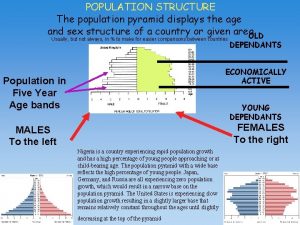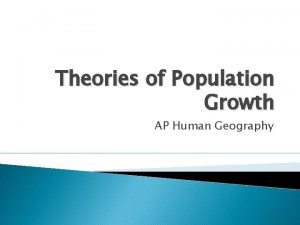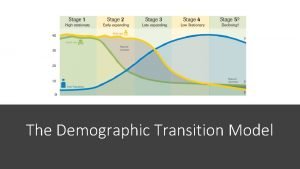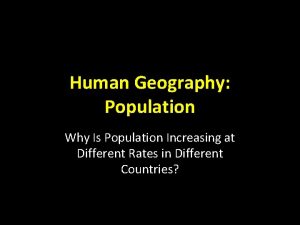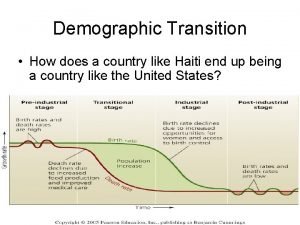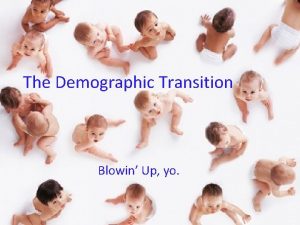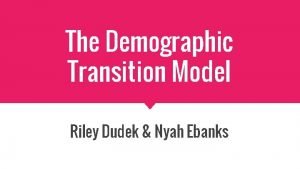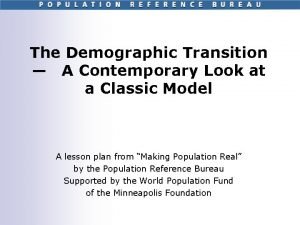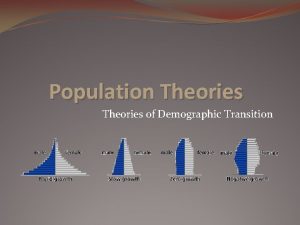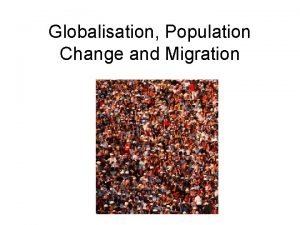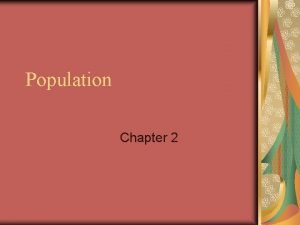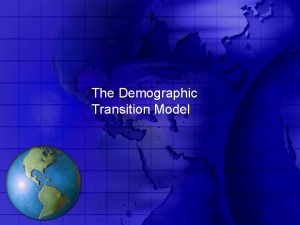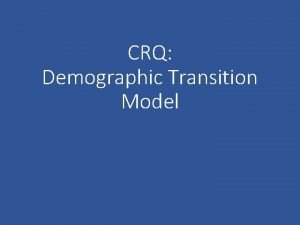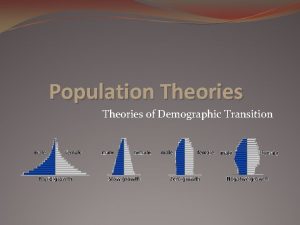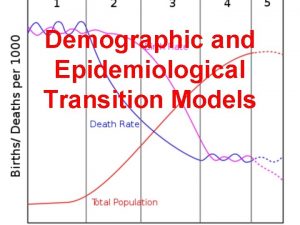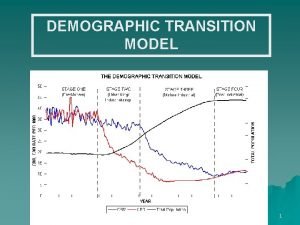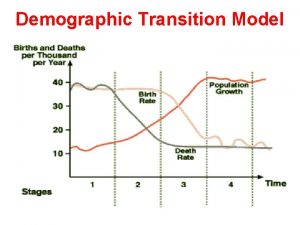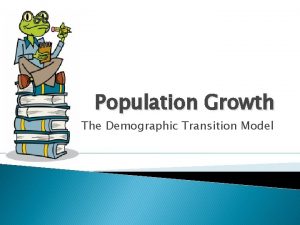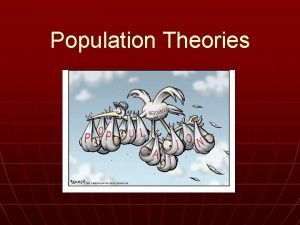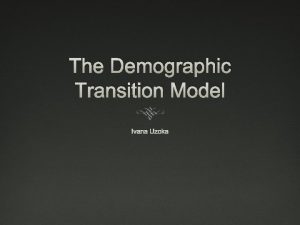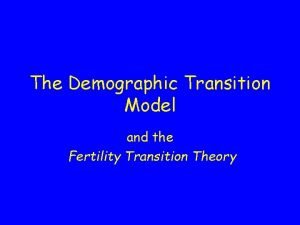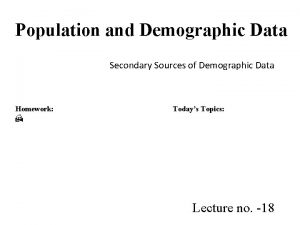DEMOGRAPHIC TRANSITION MODEL A Model of Population and





















- Slides: 21

DEMOGRAPHIC TRANSITION MODEL A Model of Population and Natural Increase Rate

A PREDICTIVE AND DESCRIPTIVE MODEL ● Several stages (1 -5) that societies go through that illustrates population growth and development in a country over time ● Widely accepted throughout the field of geography. ● All countries go through it, but at different rates and at different times. Historically, no country has ever reverted back to a previous stage. Thus, the model can be thought to have a beginning, middle, and an end.

OVERVIEW

STAGE 1 LOW ● High. GROWTH CBR ● High CDR ● Zero or very low NIR ● Low population level ● Most of human history, but no countries today (mainly 8000 BCE to around 1750 AD) ● Very low standard of living: little education, no medical care, no industrialization, rural dwellers, subsistence economy ● Food supplies were unpredictable and lifethreatening, disease commonplace

STAGE 2 -HIGH GROWTH ● High CBR ● CDR begins to drop rapidly ● NIR increases rapidly ● Population gets larger (very quickly) ● First experienced in Britain and Western Europe during the Industrial Revolution (late 1700 s) ● Improved medical technology and sanitation systems accompany this stage ● Pollution (increased industrialization), mass production (cash economy), some medical care, some education, increasingly urban ● Many countries throughout Africa and parts of Asia today

STAGE 3 MODERATE GROWTH ● CDR continues to drop ● CBR begins to drop ● NIR drops rapidly ● Population continues to grow, but less rapidly ● Population is at its highest level ● CBR drops because people decide to have fewer children once IMR declines. ● Smaller families, higher standards of living, medical and education for most, urbanized society, highly industrialized ● Latin America & Asia for the most part

STAGE 4 -LOW GROWTH ● CDR is equal to CBR, but both are at low levels ● Zero Population Growth (ZPG) ● TFR continues to fall ● NIR is zero ● Population stays constant at a high level – “Zero Population Growth (ZPG)”-when TFR of 2. 1 ● Urbanized societies with educated workforces, continued medical advances, gender equality; high end service industry drives economy ● Most Western European countries, U. S. , & Canada

OVERVIEW

WHY DOES POPULATION GROWTH VARY AMONG REGIONS? Declining Birth Rates Two Successful Strategies for Lowering Birth Rates Improving Education and Health Care Emphasizes improving local economic conditions so that increased wealth is allocated to education and health programs seeking to lower birth rates. 2. Contraception More immediate results reaped than previous approach Met with greater resistance, because it goes against cultural or religious beliefs of some. 1. Roman Catholics, fundamentalist Protestants, Muslims, and Hindus.



Why Does Population Growth Vary among WHY DOES POPULATION GROWTH Regions? VARY AMONG REGIONS? Thomas Malthus (1766 -1834) on Overpopulation He claimed the population was growing faster than the increase in food supply. Malthus’s Critics Many geographers consider his beliefs too pessimistic. Malthus’s theory based on idea that world’s supply of resources is fixed rather than expanding. Many disagree that population increase is not a problem. Larger populations could stimulate economic growth, and therefore, production of more food.

Why Does Population Growth Vary among WHY DOES POPULATION GROWTH Regions? VARY AMONG REGIONS? Malthus on Overpopulation Theory and Reality Food production has increased over last 50 years faster than Malthus predicted. His model predicted world population to quadruple over the course of 50 years. Not even in India has population growth outpaced food production.


STAGE 5 – NEGATIVE GROWTH? ? ? • • • A new stage that is developing as a result of death rates exceeding birth rates. Primarily in post-industrial countries where lifestyle choices have produced a desire for fewer children. Most choices appear to be for economic purposes. Japan – as a result of rapid urbanization and the changing role of women in a country that has a restrictive immigration policy. Russia largely due to affects of communism which has left a heavily polluted environment and a state of depression among the people that has created a desire for fewer children. Other western and eastern European countries for similar reasons.



BASIC ASSUMPTIONS OF MODEL ●This process goes along with increased industrialization, technology, and medical advances in a country. ●All countries will develop along the same patterns as western Europe throughout the 1800 s and 1900 s. ●Does not take into account immigration or emigration.

CRITIQUE OF DEMOGRAPHIC TRANSITION ● Some countries did not. MODEL go through early stages (United States, Australia) ● China, Brazil, and Thailand passed through stages quickly due to fast social and economic change ● Some African countries appear to be stalled in 2 nd stage due to stagnant development and the effect of AIDS ● Doesn’t take into consideration disease and other wide-spread population reducers (war) ● Western Europe and the United States were able to go through the stages because of exploitation of human and natural resources from other places. Will the LDCs have access to the same resources?

Keep in mind while the DTM cannot necessarily predict the future-it does give an indication of what the future birth and death rates may be for an underdeveloped country.

 Demographic transition model population pyramids
Demographic transition model population pyramids Population distribution
Population distribution Uk demographic transition model
Uk demographic transition model Uk demographic transition model
Uk demographic transition model Demographic transition model ap human geography
Demographic transition model ap human geography Denmark demographic transition model
Denmark demographic transition model Warren thompson demographer
Warren thompson demographer Haiti dtm stage
Haiti dtm stage Demographic transition theory
Demographic transition theory Demography ap human geography
Demography ap human geography Demographic transition model worksheet
Demographic transition model worksheet Demographic transition model song
Demographic transition model song Demographic transition model uk
Demographic transition model uk Afghanistan demographic transition model
Afghanistan demographic transition model Demographic transition model example
Demographic transition model example Demographic transition model
Demographic transition model Boserup
Boserup Demographic transition theory
Demographic transition theory Two big breaks in the demographic transition
Two big breaks in the demographic transition Demographic transition
Demographic transition Importance of studying population
Importance of studying population Chapter 4 section 1 population dynamics answer key
Chapter 4 section 1 population dynamics answer key
